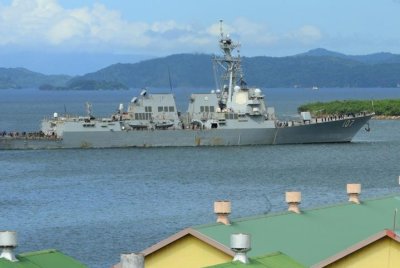Trinidad and Tobago confirms U.S. radar installation to combat drugs

The U.S. Navy destroyer USS Gravely arrives in Port of Spain, Trinidad and Tobago, in late October to conduct military exercises over several days as part of Washington’s naval deployment in the Caribbean Sea. File Photo by Andrea de Silva/EPA
Dec. 4 (UPI) — Trinidad and Tobago Prime Minister Kamla Persad-Bissessar confirmed her government allowed installing a U.S. radar system to help combat the movement of sanctioned Venezuelan oil, drug trafficking, firearms, ammunition and irregular migration.
The radar was placed at the new A.N.R. Robinson International Airport on the island of Tobago, a strategic location facing Venezuela’s eastern coast.
In a press statement, the prime minister said violent crime in Trinidad and Tobago over the past decade has been driven by the local drug-trafficking mafia and by Venezuelan criminal collaborators evading sanctions, the Trinidad Guardian reported.
“When we took office, we found a radar system that operated sporadically and inefficiently and did not cover our entire territory. Our Coast Guard could not even access real-time data, and the system had been compromised,” she said.
Persad-Bissessar said she requested temporary assistance from the U.S. Embassy “until we could secure a permanent replacement for the existing system.”
She stressed that the infrastructure does not turn the country into a U.S. military base, but is part of security cooperation agreements.
“The radar is solely for monitoring and surveillance of our territory. It will not be used in any action in Venezuela,” the prime minister said.
Although Persad-Bissessar initially dismissed suggestions that the U.S. presence on the island was military in nature, saying the United States was helping improve the Arthur N.R. Robinson International Airport, she later acknowledged that she had deliberately concealed the purpose of the U.S. deployment.
She argued that publicly disclosing the information would have endangered national security.
The radar prompted questions from the opposition People’s National Movement, whose members demanded greater transparency about the operation.
In response, Persad-Bissessar accused the opposition of “ignoring the illegal trafficking of drugs and people driven by Venezuela.”
She added that “the questions raised by the [People’s National Movement] about the newly installed radar are a desperate effort to force the government to reveal sensitive national security information to help the alleged financiers of the local drug mafia and the PNM’s Venezuelan criminal collaborators evade surveillance.”
Since September, the United States has expanded its military presence and access agreements in the Caribbean, saying the effort is aimed at combating drug trafficking and supporting “stability” in the region.
Persad-Bissessar has backed U.S.-led initiatives in the region, despite international criticism over the deaths of suspected drug traffickers in international waters.
Venezuelan President Nicolás Maduro’s government, meanwhile, has accused Persad-Bissessar of allowing Trinidad and Tobago to be used for regime-change attempts.
In October, Maduro suspended an energy cooperation project with the country, signaling that the bilateral relationship was strained.
Tensions rose further last week after U.S. President Donald Trump said ground attacks against Venezuela would begin “very soon.”
